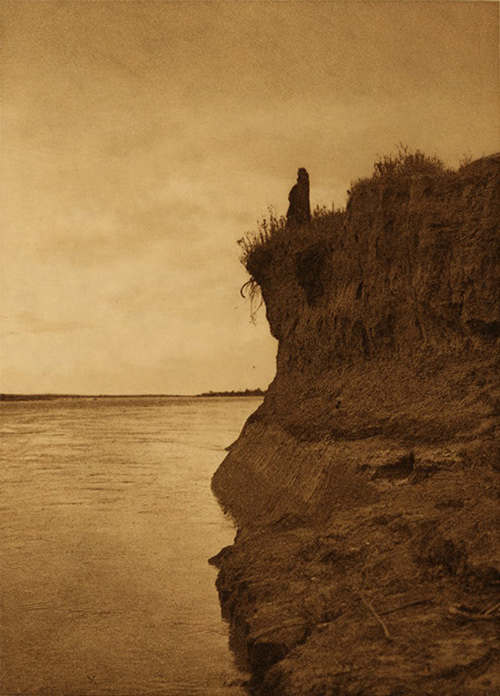At Fort Mandan, Big White (Shekeke) and Big Man tell Clark that several Mandan men left the Knife River Villages to consult their Medicine Stone. Lewis‘s hunting party returns with about 3,000 pounds of meat.
The Medicine Stone
by Yellowstone Public Radio[1]Originally aired weekdays by Yellowstone Public Radio during the Bicentennial observance of 2003-2006. Narrated by Hal Hansen. Scripts by Whit Hansen and Ed Jacobson. Produced by Leni Holliman. © … Continue reading
On the Banks of the Missouri
Edward S. Curtis (1868–1952)
Northwestern University Library, Edward S. Curtis’s “The North American Indian,” 2003. https://curtis.library.northwestern.edu/site_curtis. For educational, non-commercial use only.
Mandan Medicine Stone
Visited by the big white & Big man they informed me that Several men of their nation was gorn to Consult their Medison Stone about 3 day march to the South West to know What was to be the result of the insuing year— They have great confidence in this Stone and Say that it informs them of every thing which is to happen, & visit it every Spring & Sometimes in the Summer—”They haveing arrived at the Stone give it Smoke and proceed to the wood at Some distance to Sleep the next morning return to the Stone, and find marks white & raised on the Stone representing the piece or war which they are to meet with, and other changes, which they are to meet”
—William Clark
The stone is described as being marked with impressions of the footsteps of men, and animals of various descriptions, also of sledges with dogs. The Indians use this stone as an oracle, and make offerings of value to it, such as kettles, blankets, cloth, guns, knives, hatchets, medicine pipes, &c., which are found deposited close to it. The war parties of both nations [Mandan and Hidatsa], when they take the field, generally go to this place, and consult the oracle as to the issue of their enterprise. Lamenting and howling, they approach the hill, smoke their medicine pipes, and pass the night near the spot. On the following morning they copy the figures on the stone upon a piece of parchment or skin, which they take to the village, where the old men give the interpretations. New figures are undoubtedly drawn from time to time on this stone, near to which the celebrated ark, in which part of the nation was saved in the great deluge, formerly stood.[2]Part 2 of Maximilian, Prince of Wied’s, Travels in the Interior of North America, 1832–1834 in Reuben G. Thwaites, Early Western Travels 1748-1846 (Cleveland: The Arthur H. Clark Company, … Continue reading
3,100 Pounds of Meat
we Set off eairly and proceeded on verry fast. the Snow and Ice thoughed on the River considerable So that it was wet & Slopy halling the Sled.
—John Ordwaythe meet which he [Lewis] killed and that in the lower Deposit amounting to about 3000 wt was brought up on two Slays, one Drawn by 16 men had about 2400 wt on it
—William Clark
Weather Diary
State of the Ther. at rise
Weather Wind at rise
Thermt. at 4 oCk. P.M. Weather Wind at 4 oCk. P.M. River 6 [above 0] fair S 30 [above 0] fair S Cap Lewis return with about [3,100] w of meat
—William Clark[3]To assist the reader, the editor of this web page has omitted the date column, merged the “State of the River atrise” columns, and spelled out some abbreviations.
Experience the Lewis and Clark Trail
The Lewis and Clark Trail Experience—our sister site at lewisandclark.travel—connects the world to people and places on the Lewis and Clark Trail.
Plan a trip related to February 21, 1805:

Fort Mandan is a High Potential Historic Site along the Lewis and Clark National Historic Trail managed by the U.S. National Park Service. The North Dakota Department of Parks and Recreation manages a modern reconstruction and the Lewis and Clark Interpretive Center located at US Hwy 83 and ND Hwy 200A.
Knife River Indian Villages National Historic Site is a High Potential Historic Site along the Lewis and Clark National Historic Trail managed by the U.S. National Park Service. A unit of the National Park System, the site is located at 564 County Road 37, one-half mile north of Stanton, North Dakota. It has exhibits, trails, and a visitor center.
Notes
| ↑1 | Originally aired weekdays by Yellowstone Public Radio during the Bicentennial observance of 2003-2006. Narrated by Hal Hansen. Scripts by Whit Hansen and Ed Jacobson. Produced by Leni Holliman. © 2003 by Yellowstone Public Radio. |
|---|---|
| ↑2 | Part 2 of Maximilian, Prince of Wied’s, Travels in the Interior of North America, 1832–1834 in Reuben G. Thwaites, Early Western Travels 1748-1846 (Cleveland: The Arthur H. Clark Company, 1906), 23:339–40 available at archive.org/details/earlywesterntrav23thwa/ |
| ↑3 | To assist the reader, the editor of this web page has omitted the date column, merged the “State of the River at  rise” columns, and spelled out some abbreviations. rise” columns, and spelled out some abbreviations. |



